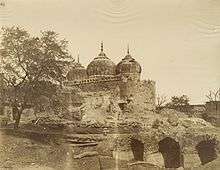Qudsia Bagh
Qudsia Bagh (English: Qudsia Garden) is an 18th-century garden complex and palace located in Old Delhi, India.


History
The complex was constructed in 1748[1] for Qudsia Begum, the mother of Mughal emperor Ahmad Shah Bahadur. It is situated north of the old city. Formerly a splendid palace, it belonged to the heir apparent[2] before falling into disrepair.[3] Large parts of it were destroyed during the Indian rebellion of 1857.[4]
Today only an entrance gate, the Shahi (Emperor's) mosque[5] and the stables remain.[6] Historian Hasan Zafar notes that the garden has been recorded as a protected monument in the Archaeological Survey of India records.[7] There are plans by the Municipal Corporation of Delhi to rename Qudsia Bagh "MM Aggarwal Park", after the city commissioner, which has raised protests.
See also
- Sunehri Masjid (Red Fort)
References
- Bakht Ahmed, Firoz (8 January 2013). "Qudsia Bagh to become Aggarwal Park!". The Milli Gazette. Retrieved 8 December 2013.
- "The Qudsia Bagh". British Library. 26 March 2009. Retrieved 8 January 2014.
- Sharma, Manimugdha S (24 March 2013). "Paradise lost: How Delhi's historic Qudsia Bagh is dying". The Times of India. Retrieved 8 December 2013.
- Kumari, Kajal (5 February 2009). "Qudsia Bagh: A walk in the park at a heritage bagh". The Indian Express. Retrieved 8 December 2013.
- "Khadsia Bagh Musjid, Delhi". British Library. 26 March 2009. Retrieved 8 January 2014.
- "Khoodsia Baug [Qudsia Bagh] Musjeed, Delhi". British Library. 26 March 2009. Retrieved 8 January 2014.
- Volume II, p. 295, No. 11
External links
![]()